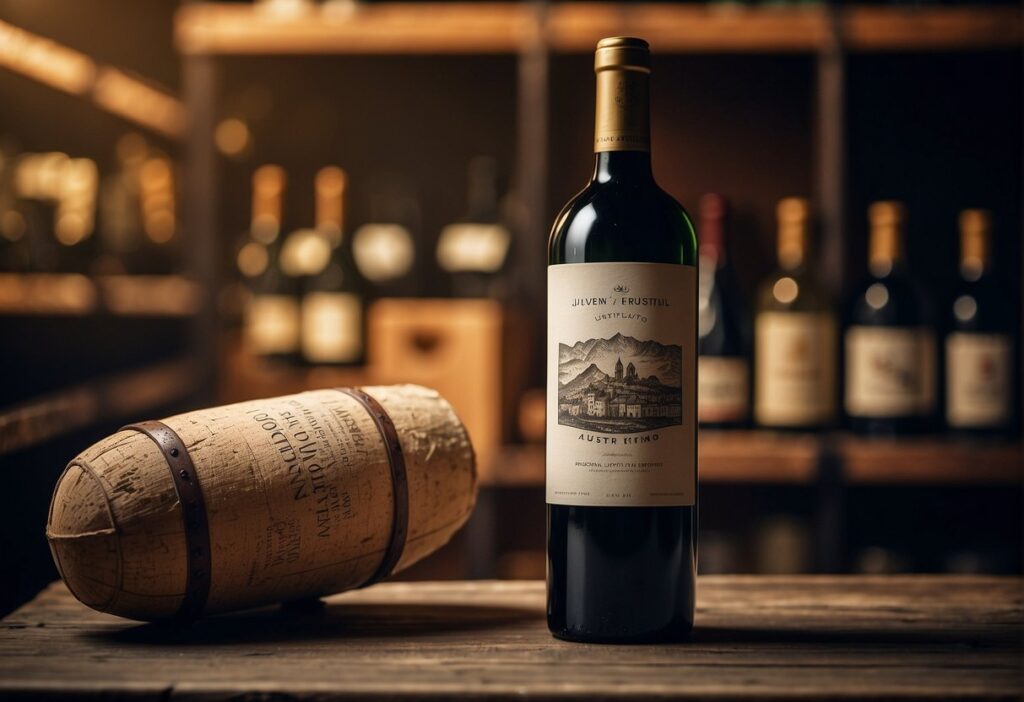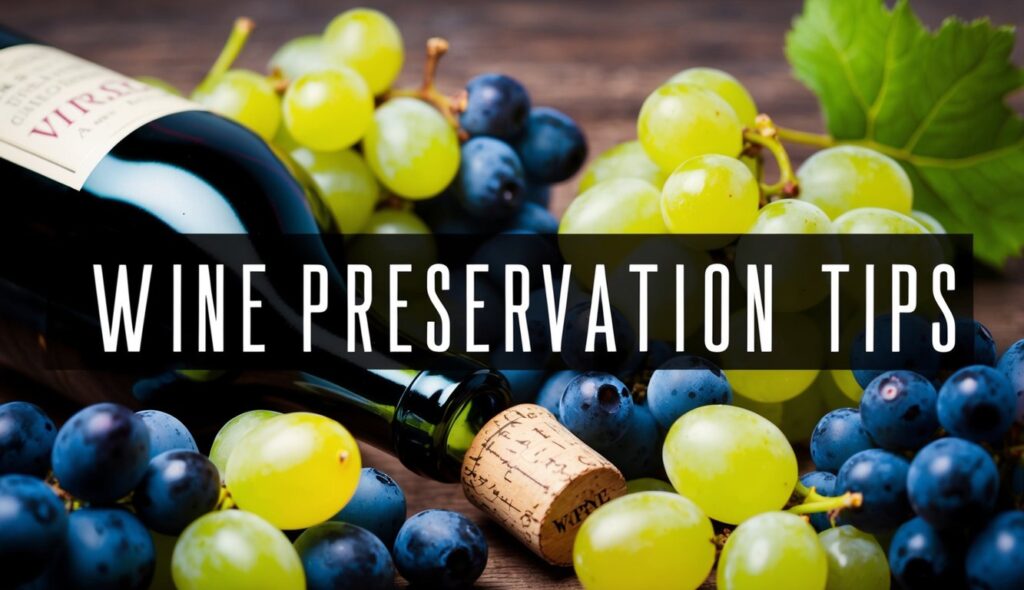Wine aging is a fascinating journey that changes the character of the wine over time. The aging process of wine involves chemical reactions that can enhance its flavors and aromas, making it more enjoyable to drink. You might think all wines are meant to be aged, but this isn’t the case. Only certain types, such as some reds and select whites, benefit from this development.

When deciding which wines to age, several factors come into play.
- Storage conditions are crucial for wine aging, with the ideal environment being consistent temperatures between 53-57°F.
- Keeping bottles in a dark, cool place ensures the slow, even maturation of the wine. This helps to preserve the wine’s structure and prevents it from spoiling.
Your choice of wine to age should match your personal taste and patience. Some wines reach their peak in as little as five to ten years, while others may need decades. Aged wines can offer complex and profound experiences that are cherished by wine enthusiasts around the world. Understanding the art of wine aging can enhance your appreciation and make the wait rewarding.
Basics of Wine Aging
Wine aging involves a complex blend of chemical processes that enhance the flavor and aroma of the wine. Key elements such as tannins, acidity, and oxygen play crucial roles in this transformation, affecting everything from taste to texture.
Importance of Tannins and Acidity
Tannins are compounds found in grape skins, seeds, and stems. They are vital to the aging process because they contribute to the wine’s structure and stability. As wine ages, tannins undergo polymerization, a process that softens their taste, making the wine smoother and less astringent over time.
Acidity is just as essential. It acts as a natural preservative, helping to balance flavors and prevent spoilage. During aging, the acidity in wine can mellow, allowing subtler flavors to emerge. Wines high in acidity often age better, maintaining their freshness even after many years.
Wine Aging and Oxygen Interaction
Oxygen can have both positive and negative effects on wine. During the aging process, a small amount of oxygen exposure is beneficial. It facilitates oxidation, which can enhance complex flavors and aromas. This interaction is carefully controlled in a process known as micro-oxygenation.
However, too much oxygen can lead to spoilage. The balance is delicate; hence, wines are often stored in bottles with tight seals. This minimizes unwanted chemical reactions that could spoil the wine. Understanding this balance is crucial for aging wine successfully, ensuring that it matures as desired without losing its essential qualities.
Types of Wines and Aging Potential
Wine aging can enhance flavors and aromas, transforming the taste of certain wines. Different types of wine age in unique ways, influenced by their grape varietals, tannin levels, and sugar content.
Red Varietals: Cabernet Sauvignon to Nebbiolo
Cabernet Sauvignon is known for its high tannin and acidity, which gives it a long aging potential. You might find that this wine can age from 5 to 20 years or more, depending on production methods and quality. This allows the flavors to deepen and soften, bringing out complexities.
Nebbiolo, primarily from Italy, exhibits similar traits with high tannins and acidity. It can also age for decades, developing aromas of tar and roses. Other red varietals such as Syrah and Merlot also benefit from aging. Syrah gains richness, while Merlot softens and becomes more nuanced over time.
Aging White Wines: Chardonnay to Riesling
Not all white wines benefit from aging, but some do quite well. Chardonnay, especially those from Burgundy, can age for 5 to 10 years. This aging process often enhances creaminess and adds nutty or buttery notes due to oak influence.
Riesling is another white varietal with good aging potential. High-acid Rieslings, especially from Germany, can age for decades. This aging can introduce honeyed and petrol notes, adding complexity beyond the sweet or dry flavors present in its youth.
Fortified and Sweet Wines: Port to Sauternes
Fortified wines like Port are crafted for longevity. With higher alcohol content, Port can age for 20, 30, or even 40 years. It develops layers of flavor, such as dried fruit and spice.
Similarly, Madeira is known for its extraordinary aging ability, often lasting 100 years. Sauternes, a sweet wine, benefits from its sugar content, allowing it to age for decades. Over time, Sauternes develops rich flavors like caramel, apricot, and almond, making it a prized collectible.
Each type of wine presents its own unique journey through aging, enhancing different qualities and rewarding patience.
Wine Aging Environments

Wine aging environments play a crucial role in how a wine’s flavors develop over time. Factors such as storage conditions and the sealing method used for the wine bottle greatly influence the aging process.
Wine Cellar Conditions
A wine cellar provides an ideal environment for aging wine. The temperature should stay around 55°F (13°C) to keep the wine stable. Fluctuating temperatures can make the wine age too quickly or spoil the flavor.
Humidity levels also matter in wine storage, ideally staying between 60-70%. This prevents the cork from drying out, maintaining a good seal and avoiding oxidation. Wines should be stored horizontally to keep the cork moist and ensure it remains sealed properly. These conditions help in developing the wine’s tertiary notes, which include aromas developed with age.
A well-maintained wine cellar mimics these conditions to bring out the best characteristics of the wine. You can learn more about this from the Science Behind Wine Aging.
Influences of Bottle Sealing Methods
The method used to seal a wine bottle affects its aging.
- Cork seals are traditional and allow small amounts of oxygen to interact with the wine. This interaction can enhance aroma and complexity but requires precise control of the storage environment to avoid spoilage.
- Screw caps, on the other hand, create a tight seal. They prevent oxygen from entering, which can maintain the wine’s freshness but may limit the development of complex tertiary notes.
Each sealing type has its benefits depending on the kind of wine and desired aging effects. For wines sealed with corks, maintaining proper pressure and sealing conditions is essential to maximize the wine’s potential during aging. Find more insights on wine aging in Wine Aging Technology.
Aging in Oak Barrels vs. Bottles

In the world of winemaking, the choice of aging method plays a pivotal role in shaping a wine’s flavor and aroma. Both oak barrels and bottle aging offer distinct benefits, influencing the wine in unique ways.
Role of Oak in Wine Aging
When wine is aged in oak barrels, it absorbs not only the flavors of the oak but also undergoes micro-oxygenation. This process involves small amounts of oxygen entering the wine, softening tannins and improving mouthfeel.
Oak barrels impart aromas and flavors such as vanilla, caramel, spice, and toast. These flavors are especially prominent in wines like Bordeaux and Chardonnay.
The toasting level of the barrel also influences the wine. Light toasting adds subtle aromas, while heavy toasting can introduce stronger, smoky notes. The age of the barrel matters too. New oak provides more intense flavors, while older barrels give more subdued traits. Oak aging is a crucial step, tailored by winemakers to achieve specific taste profiles.
Developing Complexity in Bottle Aged Wines
Bottle aging refers to the time wine spends maturing in the bottle after initial production. This stage allows for the development of tertiary aromas, like earthiness and nuttiness, which emerge over time.
Bottle aging enhances the wine’s complexity and can lead to more integrated flavors, softening harsh edges. The absence of oxygen plays a key role in this process. Without oxidation, wines develop more subtle flavors, focusing on the layering and deepening of existing notes.
Bottle aging suits wines intended for long-term cellaring, such as vintage reds or premium whites, allowing for an evolving sensory experience. This method emphasizes the potential for wines to gain extraordinary depth, offering a refined drinking experience.
Wine Regions and Their Aging Philosophies

In the world of wine, different regions have unique approaches to aging. These philosophies reflect the local culture, history, and techniques developed over centuries. From the time-tested traditions of Bordeaux and Burgundy to the innovative practices in New World regions, each method offers something distinct.
Old World Traditions: Bordeaux and Burgundy
In the Bordeaux wine region, aging is a key aspect of winemaking. Bordeaux wines often use a blend of grape varieties like Cabernet Sauvignon and Merlot. These blends are matured in oak barrels, allowing the wines to develop complex flavors and aromas over time. The influence of the local terroir, with its unique soil and climate, plays a significant role in shaping the wine’s character.
Burgundy, on the other hand, focuses on single-variety wines, often using Pinot Noir and Chardonnay grapes. This region values the expression of terroir, which is why many Burgundy wines are aged longer to enhance their subtle nuances. The tradition here is meticulous, with winemakers prioritizing the natural elements that influence each bottle’s development.
New World Innovations and their Impact on Aging
New World wine regions, like those in the United States and Australia, approach wine aging with a different perspective. They often experiment with different grape varieties such as Grenache and Sangiovese, and innovate with rosé wine production.
These regions are less bound by tradition, which allows for creative winemaking. The impact of these innovations is significant. They offer wines that may be ready to drink sooner, yet still possess the depth and complexity achieved through aging.
Technologies like controlled fermentation and various barrel aging methods further enhance the flavors and textures. They demonstrate the dynamic nature of New World wine aging.

